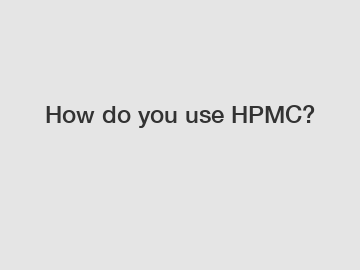Nov. 07, 2023
Chemicals
For more information, please visit .
HPMC, short for Hydroxypropyl Methylcellulose, is a widely used polymer in various industries due to its excellent film-forming, rheology-controlling, and adhesive properties. With its versatile applications in fields such as pharmaceuticals, construction, personal care, and food, understanding how to use HPMC effectively is crucial for professionals in these industries.
In the pharmaceutical industry, HPMC plays a significant role in drug delivery systems. Its film-forming properties allow it to be used as a coating material for tablets and capsules, protecting the active ingredients from degradation and improving bioavailability. To use HPMC in the pharmaceutical industry, it is important to consider the desired release profile, dosage form, and compatibility with other excipients.

One of the key aspects of using HPMC in pharmaceutical applications is understanding the viscosity grade. Different viscosity grades of HPMC provide diverse solutions based on the requirements of the formulation. For instance, a higher viscosity grade is commonly used for sustained-release formulations, while a lower viscosity grade is suitable for immediate-release products. By carefully selecting the appropriate viscosity grade, pharmaceutical professionals can achieve the desired drug release profile, ensuring the effectiveness of the medication.
In addition to drug delivery systems, HPMC is also utilized in ophthalmic solutions as a lubricating agent to improve the comfort and retention time of eye drops. Due to its high water-retention capacity, HPMC helps maintain a moist environment on the ocular surface, reducing the frequency of administration. It is essential to consider the concentration of HPMC in eye drops, as higher concentrations may lead to increased viscosity, potentially affecting the patient's comfort.
Moving to the construction industry, HPMC is widely used as an additive in cement-based materials, mortars, and adhesives. Its role is to improve workability, water retention, and reduce cracking. In cement-based materials, HPMC acts as a thickener, providing a consistent and smooth texture, while controlling the rate of water evaporation. This allows for proper hydration of cement particles, leading to higher strength and durability of the final product.
To effectively use HPMC in construction materials, it is essential to consider the appropriate dosage. The concentration of HPMC should be carefully adjusted depending on factors such as the desired workability, setting time, and environmental conditions. The compatibility of HPMC with other additives and the specific cement used should also be taken into account to ensure a successful application and achieve the desired properties.
In the personal care industry, HPMC finds its application in various products such as shampoos, creams, and lotions. It serves as a thickening agent, enhancing the texture and stability of cosmetic formulations. When used in shampoos, HPMC increases the viscosity, allowing for better foamability and cleaning performance. In creams and lotions, it improves spreading and provides a smooth, non-greasy feel.
For personal care formulations, it is vital to choose the appropriate HPMC grade based on the desired viscosity and specific requirements of the product. HPMC can be easily dispersed in water, and its solubility can be adjusted by altering the degree of substitution. Professionals in the personal care industry should experiment with different concentrations and formulations to achieve the desired texture and stability of their products.
Lastly, in the food industry, HPMC is used as a food additive to improve texture, stability, and appearance. It is often found in applications such as sauces, dressings, and bakery products. In these products, HPMC acts as a thickener, preventing phase separation and maintaining a desirable mouthfeel. Moreover, HPMC can be used as a film-former to coat fruits and vegetables, extending their shelf life and protecting against moisture loss.
When using HPMC in food applications, it is crucial to adhere to regulatory guidelines to ensure food safety. The concentration of HPMC should be carefully monitored to avoid any negative effects on taste or texture. It is essential to consider the specific food product, pH level, and processing conditions to achieve the desired functionalities without compromising the quality.
In conclusion, HPMC is a versatile polymer that finds applications in various industries. Its film-forming, rheology-controlling, and adhesive properties make it an indispensable ingredient in pharmaceuticals, construction, personal care, and food products. By understanding the specific requirements and selecting the appropriate viscosity grade or concentration, professionals can effectively use HPMC to achieve the desired properties, ultimately enhancing the performance and quality of their products.
You can find more information on our web, so please take a look.
If you want to learn more, please visit our website pva powder suppliers.
Previous: Is Exterior Insulation and Finish Systems a Game Changer in Energy Efficiency?
Next: Methyl Methacrylate Production Plant: Crafting Quality in Every Step
If you are interested in sending in a Guest Blogger Submission,welcome to write for us!
All Comments ( 0 )